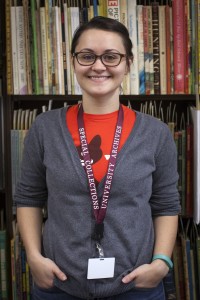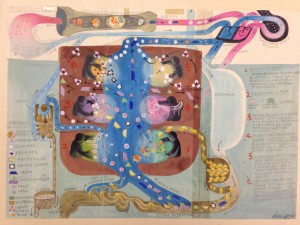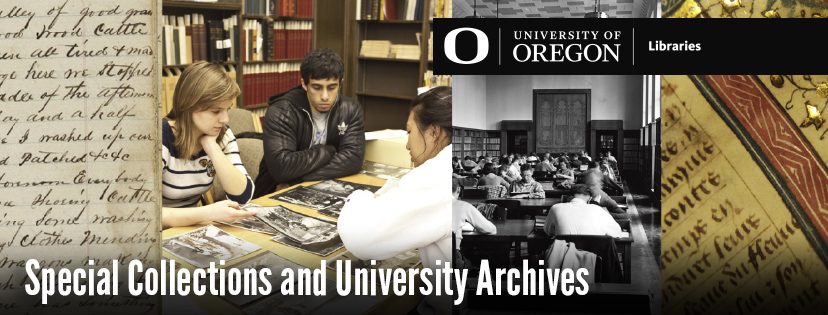Student Spotlight: Alexa Goff
In celebration of Children’s Book Week, we interviewed Alexa Goff, one of Special Collections and University Archives amazing student workers who assist staff daily on numerous projects. Our Student Spotlight series highlights these students to showcase their outstanding work, academic interests, and some of their favorite collections in our repository.

Name: Alexa Goff
Major: Art History
Year in School: Graduate
Job in SCUA: Student Processing Assistant
Tell us a little bit about what brought you to Special Collections and University Archives? What made you want to work here, as opposed to other places on campus?
Upon entering my graduate program, actually the summer before I even started, I was anxious to explore any learning opportunities that might be available at the Knight Library. I first came to the Beach Conservation Lab as a conservation assistant, and the lead conservator soon referred me to SCUA after learning more about my interests in special collections.
As a student focused on the research of historical objects and artwork, working in Special Collections and University Archives is the one place I most wanted to be involved with on campus. I was incredibly fortunate that employment was available and so today not only am I employed on campus but I am also learning important archival and processing skills I wish to apply towards my intended career of librarianship.
You’ve worked on some pretty interesting and wide-ranging collections during your time here, are there any you’d like to highlight?
When I started, my first task was to complete the processing for the James Daugherty papers. This collection has an enormous volume of original artwork, illustrations, and manuscript material for his many children’s literature publications. It was a challenge to jump in and learn proper methods of physical and intellectual arrangement for a collection of this size, but because of this challenge its completion felt extra exciting.
What are you working on right now?
I am currently processing the Cornelius DeWitt papers. This collection includes a large quantity of artwork and illustrations he created for children’s literature publications, many of which were published by Golden Books.
Which collection have you most enjoyed working with? What were some of the coolest things you found in the collections you’ve worked with?
It’s very hard to choose a favorite collection in children’s literature. It is a rare treat to spend so much time with an artist’s archives, and I love beginning a new collection and first learning about their publication history and styles, but then often have the opportunity to expand this understand and witness the larger picture of their artistic career. For example, James Daugherty worked prolifically with oil crayon and ink for his children’s literature publications, but also had an important career as a Modernist painter and muralist and this diversity is represented in our collection. Virginia Lee Burton, whose beloved children’s books are still in print today, also founded a hand-printed textile collective and some of these original designs on paper appear in our archives.

As a historian interested in science, however, the work of Cornelius DeWitt has been really enjoyable for me in particular. In books teaching children of the complex processes of the human body or the geography of the earth, we get to see finely detailed illustrations executed in surprising media such as cut paper collage. With publication dates in the early to mid-twentieth century, these scientific illustrations and text are fascinating because they showcase a particular moment in scientific history that we’ve now left behind. For example, in an delicate paper collage a family gazes at the stars above and the caption reads “Many people would like to visit other planets. But up to now no one has traveled in space.” These images try to strike a balance between scientific complexity and visual simplification for children. One of my favorite DeWitt illustrations that demonstrates this so well is the “Liver as Laboratory” sketch (1954) for The Golden Book of the Human Body (1959).
What have been some of the challenges of working in Special Collections and University Archives? What have you liked best?
Some of the challenges have included learning the range of preservation and housing options for such a wide variety of types of artwork. I must consider the media, substrate, fragility, and ease of use for the future viewer when determining how to physically store these objects. Every collection and item has presented a different challenge and opportunity to learn how to properly care for these archival works. My favorite part of working in Special Collections and University Archives is the chance to see and preserve this incredible children’s literature artwork. In every collection I process I feel the impact of my work on the collection’s ability to be seen and studied by future researchers. It is really exciting to have a small part in preserving history.

